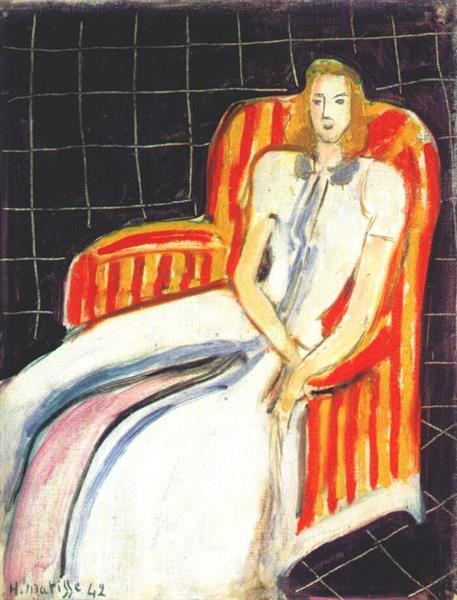Description
Henri Matisse, one of the most prominent artists of the 20th century, left a legacy of works that challenge and dazzle the viewer through the use of color and form. "Simone in Striped Armchair", painted in 1942, is a brilliant manifestation of his artistic mastery and his ability to capture the essence of his models through a harmonious play of colors and forms.
In this work, Matisse presents a young woman, Simone, sitting in a striped armchair. Simone's figure, with a serene and contemplative expression, dominates the center of the painting, becoming the focal point of the composition. It is her relaxed posture and calm gaze that give the painting an air of intimacy and tranquility.
The use of color in this work is particularly notable. Matisse, known for his chromatic boldness, employs a palette of tones ranging from deep blues to soft greens and pinks. These shades not only add depth and character to the painting but also serve to highlight Simone's figure. The contrast between the stripes of the armchair and the model's dress creates a visual dynamic that attracts and retains the viewer's gaze. The horizontal lines of the armchair oppose the verticality of Simone's figure, creating a balance that is both harmonious and vibrant.
Matisse's choice of a striped armchair is not fortuitous. The stripes not only add an intriguing design element but also act as a frame that contextualizes Simone's figure within the pictorial space. This focus on texture and pattern is characteristic of Matisse's style during the 1940s, when he was exploring the intersection between the object and its environment in an increasingly abstract manner.
Although "Simone in Striped Armchair" may seem like a simple domestic scene at first glance, it is actually a complex interaction between figure and background, color and form, serenity and dynamism. The work reflects Matisse's interest in capturing not only the external appearance of his models but also a deeper and more emotional essence. This is manifested in the way the colors and forms seem to vibrate in harmony, creating a sense of movement and life.
In the context of 1942, when World War II was in full swing, Matisse's work offers a notable contrast to the turbulence of the outside world. Amidst uncertainty and chaos, Matisse finds a space of beauty and calm, a testament to his ability to transcend immediate reality through art. This period was also marked by a quadrupling of his commitment to color and the simplicity of forms, characteristics that became the essence of his artistic legacy.
The apparent simplicity in "Simone in Striped Armchair" is deceptive, as beneath its surface lies a complex construction of lines, forms, and colors that reveal Matisse's genius. His ability to transform an everyday scene into a vibrant and lively masterpiece is what has cemented his status as one of the great masters of modernism. Observing this work, we witness the power of painting to capture and convey emotions and moods, and we reconfirm Matisse's ability to discover beauty in the simplest places and turn it into something extraordinary.

